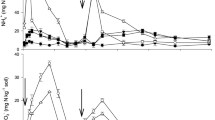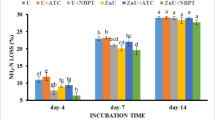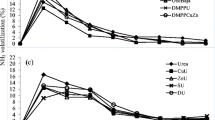Abstract
Nitrogen (N) is deficient in more than 90% of soils of Pakistan, mainly because of low organic matter contents. The use of nitrogenous fertilizers is a common practice for sustainable and profitable crop yields. A significant portion of added fertilizers is lost through volatilization, leaching, and denitrification. The low use efficiency of these fertilizers in our climate is a serious concern because of high costs and environmental issues. The present study evaluated the novel synergistic effect of urease and nitrification inhibitors such as ammonium thiosulfate (ATS) and 2-Chloro-6-(trichloromethyl)pyridine (nitrapyrin) to reduce the urea hydrolysis in the soil of three cities of Pakistan, i.e., Faisalabad, Gujranwala, and Sheikhupura, to manage the ammonia as well as N loss. Three different combinations, such as A1, A2, and A3 of both inhibitors, were prepared with varying ratios of 1:1, 0.25:0.75, and 0.75:0.25, respectively. Results showed that the minimum urea hydrolysis of about 2.41, 2.79, and 4.68 IU/g soil was observed with A1 combination after 4th-day observation with the rate of 0.50% concentration for Faisalabad, Gujranwala, and Sheikhupura, respectively. In addition, results showed better urease activity at a pH value of 6.50, incubation time of 30 min, and temperature of 37 °C for all A1, A2, and A3 combinations with 0.50% concentration. Moreover, inhibitor-treated urea showed the maximum plant height of 111, 101, and 101 cm, and root length of 15, 11, and 5 cm, number of tillers of 14, 16, and 19 per panicle, and number of spikes of 37, 21, and 38 per panicle with A1, A2, and A3 combination at 0.50% dose respectively in Faisalabad soil. Overall, it is concluded that 0.50% inhibitor concentration showed the much impressive urease inhibition results followed by 0.25 and 0.10%. However, the application of inhibitors was a good practice to reduce the N loss from soil.
Graphical abstract








Similar content being viewed by others
Data Availability Statement
All data generated or analyzed during this study are included in this article. No additional data is associated with this study.
References
Abalos, D., et al. (2014). Meta-analysis of the effect of urease and nitrification inhibitors on crop productivity and nitrogen use efficiency. Agriculture, Ecosystems Environment, 189, 136–144.
Affendi, N. M. N., Mansor, N., & Samiri, S. S. (2020). Addition of chemical and natural urease inhibitors in reducing ammonia and nitrous oxide losses. Journal of Soil Science Plant Nutrition, 20(1), 253–258.
Afshar, R. K., et al. (2018). Agronomic effects of urease and nitrification inhibitors on ammonia volatilization and nitrogen utilization in a dryland farming system: Field and laboratory investigation. Journal of Cleaner Production, 172, 4130–4139.
Al-Garawi, Z., et al. (2017). The amyloid architecture provides a scaffold for enzyme-like catalysts. Nanoscale, 9(30), 10773–10783.
Amtul, Z., Siddiqui, R., & Choudhary, M. (2002). Chemistry and mechanism of urease inhibition. Curr. Med. Chem., 9(14), 1323–1348.
Arnamwong, S., et al. (2015). Phytoextraction of cadmium and zinc by Sedum plumbizincicola using different nitrogen fertilizers, a nitrification inhibitor and a urease inhibitor. International Journal of Phytoremediation, 17(4), 382–390.
Aşkin, T., & Kizilkaya, R. (2005). The spatial variability of urease activity of surface agricultural soils within an urban area. Journal of Central European Agriculture, 6(2), 161–166.
Benini, S., et al. (1999). A new proposal for urease mechanism based on the crystal structures of the native and inhibited enzyme from Bacillus pasteurii: Why urea hydrolysis costs two nickels. Structure, 7(2), 205–216.
Cameron, K., Di, H. J., & Moir, J. (2013). Nitrogen losses from the soil/plant system: A review. Annals of Applied Biology, 162(2), 145–173.
Cantarella, H., et al. (2018). Agronomic efficiency of NBPT as a urease inhibitor: A review. Journal of Advanced Research, 13, 19–27.
Chen, C., Baethgen, W. E., & Robertson, A. (2013). Contributions of individual variation in temperature, solar radiation and precipitation to crop yield in the North China Plain, 1961–2003. Climatic Change, 116(3), 767–788.
Dargie, S., Wogi, L., & Kidanu, S. (2020). Nitrogen use efficiency, yield and yield traits of wheat response to slow-releasing N fertilizer under balanced fertilization in Vertisols and Cambisols of Tigray, Ethiopia. Cogent Environmental Science, 6(1), 1778996.
Dawar, K., et al. (2011). Urea hydrolysis and lateral and vertical movement in the soil: Effects of urease inhibitor and irrigation. Biology Fertility of Soils, 47(2), 139–146.
Dawar, K., et al. (2012). Applying urea with urease inhibitor (N-(n-butyl) thiophosphoric triamide) in fine particle application improves nitrogen uptake in ryegrass (Lolium perenne L.). Soil Science Plant Nutrition, 58(3), 309–318.
de Fátima, Â., et al. (2018). Schiff bases and their metal complexes as urease inhibitors—A brief review. Journal of Advanced Research, 13, 113–126.
Dharmakeerthi, R. and M. Thenabadu (2013) Urease activity in soils: A review. Journal of the National Science Foundation of Sri Lanka 24(3).
Ding, W. X., Hongyan, Y. Y., & Cai, Z. C. (2011). Impact of urease and nitrification inhibitors on nitrous oxide emissions from fluvo-aquic soil in the North China Plain. Biology Fertility of Soils, 47(1), 91–99.
Frame, W. (2017). Ammonia volatilization from urea treated with NBPT and two nitrification inhibitors. Agronomy Journal, 109(1), 378–387.
Galindo, F.S., et al. (2020) Can NBPT urease inhibitor in combination with Azospirillum brasilense inoculation improve wheat development? Nutrient Cycling in Agroecosystems, 1–13.
Goos, R. J., & Guertal, E. (2019). Evaluation of commercial additives used with granular urea for nitrogen conservation. Agronomy Journal, 111(3), 1441–1447.
Grant, C. (2014). Use of NBPT and ammonium thiosulphate as urease inhibitors with varying surface placement of urea and urea ammonium nitrate in production of hard red spring wheat under reduced tillage management. Canadian Journal of Plant Science, 94(2), 329–335.
Guo, Y., et al. (2020). Air quality, nitrogen use efficiency and food security in China are improved by cost-effective agricultural nitrogen management. Nature Food, 1(10), 648–658.
Huang, M., et al. (2017). Interaction of changes in pH and urease activity induced by biochar addition affects ammonia volatilization on an acid paddy soil following application of urea. Communications in Soil Science Plant Analysis, 48(1), 107–112.
Junejo, N., et al. (2011). A field evaluation of coated urea with biodegradable materials and selected urease inhibitors. African Journal of Biotechnology, 10(85), 19729–19736.
Kafarski, P., & Talma, M. (2018). Recent advances in design of new urease inhibitors: A review. Journal of Advanced Research, 13, 101–112.
Kaneko, F.H., et al. (2019) Ammonia volatilization in response to coated and conventional urea in maize crop field. Bioscience Journal 35(3).
Khan, M., et al. (2013). Kinetics and thermodynamic study of urease extracted from soybeans. Biologia, 59(1), 7–14.
Khan, M. Q., et al. (2020). Synergistic effect of inhibitors (allylthiourea and 1, 2, 4-triazole) on the activity of wheat soil urease to reduce nitrogen loss. Case Studies in Chemical Environmental Engineering, 2, 100059.
Kopteva, L., Shabalina, L., and Kashirina, E. (2019). Ecological aspects of the world food security. in E3S Web of Conferences. EDP Sciences.
Kumar, S., Dwevedi, A., & Kayastha, A. M. (2009). Immobilization of soybean (Glycine max) urease on alginate and chitosan beads showing improved stability: Analytical applications. Journal of Molecular Catalysis b: Enzymatic, 58(1–4), 138–145.
Kumar, A., et al. (2018). Homology modeling, molecular docking and molecular dynamics based functional insights into rice urease bound to urea. P. Natl. A. Sci. India. B., 88(4), 1539–1548.
Kumari, J.A., et al., Effect of temperature on soil enzyme alkaline phosphatase. 2017.
Lam, S. K., et al. (2018). Using urease and nitrification inhibitors to decrease ammonia and nitrous oxide emissions and improve productivity in a subtropical pasture. Science of the Total Environment, 644, 1531–1535.
Lasisi, A. A., et al. (2020). Efficiency of fall versus spring applied urea-based fertilizers treated with urease and nitrification inhibitors I. Ammonia volatilization and mitigation by NBPT. Soil Science Society of America Journal, 84(3), 949–962.
Lewis, J. D., et al. (2004). Relationships between needle nitrogen concentration and photosynthetic responses of Douglas-fir seedlings to elevated CO2 and temperature. New Phytologist, 162(2), 355–364.
Li, J., et al. (2018). Combination of modified nitrogen fertilizers and water saving irrigation can reduce greenhouse gas emissions and increase rice yield. Geoderma, 315, 1–10.
Li, W.-Y., et al. (2020a). N-monoarylacetothioureas as potent urease inhibitors: Synthesis, SAR, and biological evaluation. Journal of Enzyme Inhibition Medicinal Chemistry, 35(1), 404–413.
Li, W.-Y., et al. (2020b). N-monoarylacetothioureas as potent urease inhibitors: Synthesis, SAR, and biological evaluation. J. Enzyme. Inh. Med. Chem., 35(1), 404–413.
Liu, S., et al. (2020). Evaluation of the effectiveness of N process inhibitors in paddy rice via a 15N tracing approach. Soil Biology Biochemistry, 147, 107855.
Longo, R.M. and W.J.d. Melo (2005) Urea hydrolysis in Oxisols: Effects of substrate concentration, temperature, pH, incubation time and storage conditions. Revista Brasileira de Cieˆncia do Solo, 29(4): p. 651–657.
Martins, M., et al. (2017). Strategies for the use of urease and nitrification inhibitors with urea: Impact on N2O and NH3 emissions, fertilizer-15N recovery and maize yield in a tropical soil. Agriculture, Ecosystems Environment, 247, 54–62.
Martins, M. R., et al. (2020). Optimizing the use of open chambers to measure ammonia volatilization in field plots amended with urea. Pedosphere, 31(2), 243–254.
Mazurek-Budzyńska, M., et al. (2019). Hydrolytic stability of aliphatic poly (carbonate-urea-urethane) s: Influence of hydrocarbon chain length in soft segment. Polymer Degradation Stability, 161, 283–297.
Mazzei, L., et al. (2019). The structure of the elusive urease–urea complex unveils the mechanism of a paradigmatic nickel-dependent enzyme. Angew. Chem. Int. Ed., 58(22), 7415–7419.
Meng, X., et al., Nitrification and urease inhibitors improve rice nitrogen uptake and prevent denitrification in alkaline paddy soil. Applied Soil Ecology, 2020. 154: p. 103665.
Montgomery, D.C. (2017) Design and analysis of experiments: John wiley & sons.
Ni, K., Kage, H., & Pacholski, A. (2018). Effects of novel nitrification and urease inhibitors (DCD/TZ and 2-NPT) on N2O emissions from surface applied urea: An incubation study. Atmospheric Environment, 175, 75–82.
Ning, J., Ai, S., & Cui, L. (2018). Dicyandiamide has more inhibitory activities on nitrification than thiosulfate. PloS one, 13(8), e0200598.
Picone, N., et al. (2020) Ammonia oxidation at pH 2.5 by a new gammaproteobacterial ammonia-oxidizing bacterium. The ISME Journal, p. 1–15.
Sanders, A., Assessing sulfur fertilizer response in Ontario’s corn, soybean, and winter wheat crops. 2020.
Sha, Z., et al. (2020). Effect of combining urea fertilizer with P and K fertilizers on the efficacy of urease inhibitors under different storage conditions. Journal of Soils Sediments, 20(4), 2130–2140.
Soares, J. R., Cantarella, H., & de Campos Menegale, M. L. (2012). Ammonia volatilization losses from surface-applied urea with urease and nitrification inhibitors. Soil Biology Biochemistry, 52, 82–89.
Subbarao, G., et al. (2006). Scope and strategies for regulation of nitrification in agricultural systems—Challenges and opportunities. Critical Reviews in Plant Sciences, 25(4), 303–335.
Sunderlage, B.C. (2017) Late application nitrogen on corn in Southern Illinois and soil properties affecting ammonia volatilization from urea fertilizer. Southern Illinois University at Carbondale.
Tosi, M., et al. (2020). Short-term response of soil N-cycling genes and transcripts to fertilization with nitrification and urease inhibitors, and relationship with field-scale N2O emissions. Soil Biology Biochemistry, 142, 107703.
Tubiello, F. N., et al. (2013). The FAOSTAT database of greenhouse gas emissions from agriculture. Environmental Research Letters, 8(1), 015009.
Verzeaux, J., et al. (2017). Agricultural practices to improve nitrogen use efficiency through the use of arbuscular mycorrhizae: Basic and agronomic aspects. Plant Science, 264, 48–56.
Yadav, M., et al. (2017) Strategies for improving nitrogen use efficiency: A review. Agricultural Reviews, 38(1).
Yang, G., et al. (2020). Combining Azolla and urease inhibitor to reduce ammonia volatilization and increase nitrogen use efficiency and grain yield of rice. Science of The Total Environment, 743, 140799.
Yu, S., et al. (2020). Hydrochar reduced NH3 volatilization from rice paddy soil: Microbial-aging rather than water-washing is recommended before application. Journal of Cleaner Production, 268, 122233.
Yusop, M. K., Musa, M. H., & Hussin, A. (2016). Laboratory evaluation of metal elements urease inhibitor and DMPP nitrification inhibitor on nitrogenous gas losses in selected rice soils. Water, Air, Soil Pollution, 227(7), 1–14.
Zhu, S., et al. (2020). Application of controlled release urea improved grain yield and nitrogen use efficiency: A meta-analysis. PloS one, 15(10), e021481.
Author information
Authors and Affiliations
Corresponding authors
Ethics declarations
Conflict of Interest
The authors declare no competing interests.
Additional information
Publisher's Note
Springer Nature remains neutral with regard to jurisdictional claims in published maps and institutional affiliations.
Rights and permissions
About this article
Cite this article
Hussain, A., Jahan, N., Jabeen, Z. et al. Synergistic Effect of Urease and Nitrification Inhibitors in the Reduction of Ammonia Volatilization. Water Air Soil Pollut 232, 303 (2021). https://doi.org/10.1007/s11270-021-05259-0
Received:
Accepted:
Published:
DOI: https://doi.org/10.1007/s11270-021-05259-0




